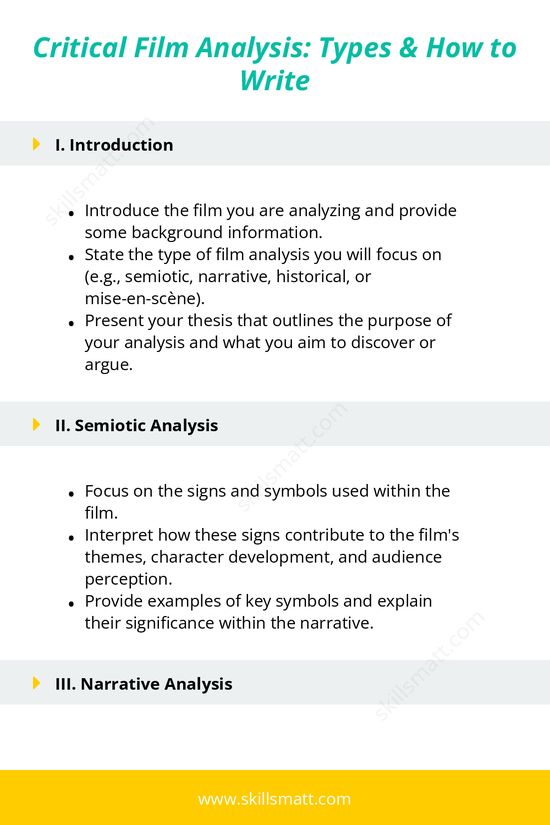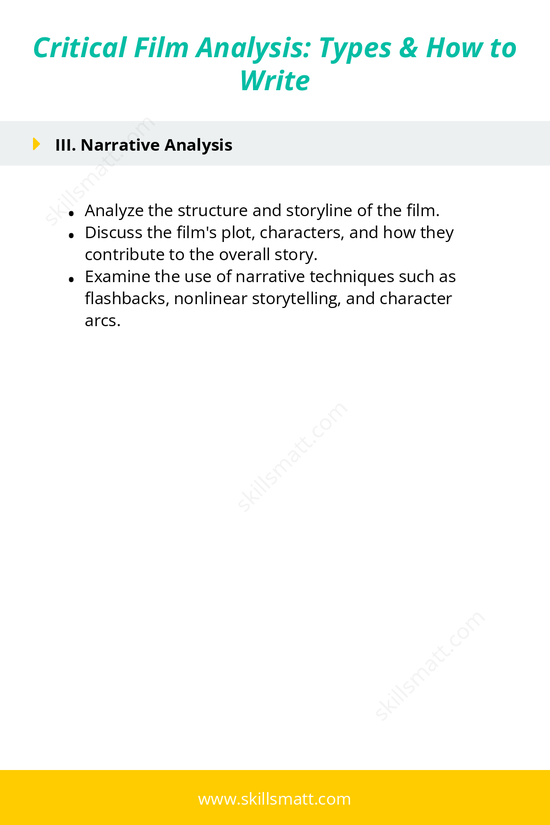Critical Film Analysis: Types & How to Write
I. Introduction
- Introduce the film you are analyzing and provide some background information: Start by naming the film and providing relevant background, such as the director and production details.
- State the type of film analysis you will focus on (e.g., semiotic, narrative, historical, or mise-en-scène): Clarify which aspect of film analysis you will be examining, such as the use of symbols, narrative structure, or historical context.
- Present your thesis that outlines the purpose of your analysis and what you aim to discover or argue: Introduce your thesis, specifying your focus and what you will argue or uncover in the analysis.
II. Semiotic Analysis
- Focus on the signs and symbols used within the film: Examine how visual elements, sounds, and other signs contribute to the narrative and themes.
- Interpret how these signs contribute to the film’s themes, character development, and audience perception: Discuss how symbols and signs help to deepen the film's meaning and shape how the audience perceives it.
- Provide examples of key symbols and explain their significance within the narrative: Use specific examples from the film to explain the meaning behind important symbols or visual motifs.
III. Narrative Analysis
- Analyze the structure and storyline of the film: Explore how the film is structured and how its story unfolds.
- Discuss the film’s plot, characters, and how they contribute to the overall story: Examine the development of key characters and how the plot builds tension and resolution.
- Examine the use of narrative techniques such as flashbacks, nonlinear storytelling, and character arcs: Look at how the director uses specific narrative techniques to influence the storytelling.
IV. Historical Analysis
- Analyze the film’s historical or cultural context: Investigate the historical setting of the film and how it reflects or shapes the story.
- Examine how the film reflects, challenges, or influences the historical period it represents: Consider how the film portrays the historical era and whether it provides a critique or reinforcement of historical events.
- Identify how the film relates to real-world events or societal issues: Discuss the ways the film connects to real-world issues or social commentary.
V. Mise-en-Scène Analysis
- Focus on the compositional elements of the film, such as lighting, camera angles, set design, and costumes: Analyze how these elements are used to convey mood, emotion, or themes.
- Analyze how these elements create mood, convey meaning, or highlight themes in the film: Discuss how the mise-en-scène enhances the viewer's understanding and emotional response.
- Provide specific examples of key scenes or shots that exemplify the use of mise-en-scène: Use specific examples of shots or scenes that illustrate how the mise-en-scène supports the narrative.


